 |
BaBars
window on the weak force The BaBar B-factory experiment at Stanford Linear Accelerator Center looks to double its data in a mere two years as it hunts for hints of spectacular new physics.
By Heather Rock Woods
|
|
Photo: Reidar Hahn, Fermilab |
|
The sun is shining; the Earth is warm instead of icy. Life is good, thanks to the weak force.
One of the four known forces that shape the universe, the weak force sustains our lives, driving the nuclear reactions that power the sun and heat the Earth’s core. It’s also tremendously useful. The weak force drives radioactive decays that diagnose disease and treat cancer, make your smoke detectors work, and indicate the age of ancient skeletons and tools.
Providing a window on the weak force are the two “B factory” experiments—BaBar at Stanford Linear Accelerator Center (SLAC) in California and Belle at KEK in Japan. They have made landmark discoveries in their first eight years of operation. Now entering the final two-year home stretch, the experiments are racing to learn even more about the weak force’s sometimes-odd behavior, and open gateways to the big mysteries of the universe. The weak force still holds secrets, and BaBar and Belle are seizing their unique opportunities to decipher them.
The B playground
The experiments’ primary tool for exploring the weak force is a heavy particle called a B meson. The B factories together have manufactured almost a billion pairs of them by slamming together electrons and their antimatter partners, positrons. The BaBar team expects to more than double its own data sample by the end of 2008. B mesons are produced in pairs: one made of matter, one made of antimatter. Each contains a bottom (or b) quark, the second heaviest quark. The b quark partners with a lighter quark to form a B meson.
“The B meson is a playground or laboratory for the weak force,” says BaBar collaborator Steve Sekula of MIT. “Left on its own without the weak force, it would hold together forever.”
Because the weak force exists, B mesons do fall apart. Physicists have determined that the ones made of matter decay at a slightly different rate than the antimatter versions. That means the weak force is lopsided: it does not act equally on matter and antimatter—unlike the other forces. This asymmetry is called charge-parity (CP) violation.
Physicists already knew CP violation existed when BaBar got underway, and they knew that this phenomenon must contribute to the dominance of matter over antimatter in the universe. The B factories confirmed that all CP violation we see in nature comes from the weak force—but they also found that it’s not enough to explain the amount of matter in the universe today. The mismatch between experimental results and the actual universe highlights the incompleteness of the prevailing theory of how nature works, known as the Standard Model. Something more is at play, and BaBar and Belle have a shot at saying who the players are.
“The matter-antimatter imbalance remains one of the top mysteries of the universe. The weak force appears not to be the thing that solves it for us. Whatever causes the imbalance, the effects are subtle,” says Sekula.
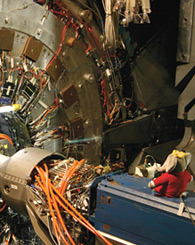 |
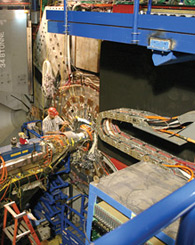 |
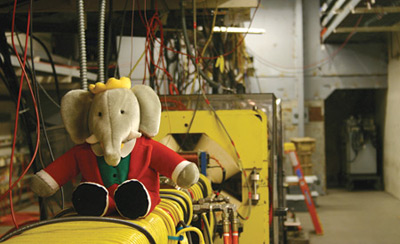 |
|
| Top photos: Technicians work on reconnecting elements of the BaBar detector after a major upgrade. Bottom photo: Babar rests in the PEP-II storage ring tunnel, his namesake detector behind the wall in the background. | |
| Photos: David Harris | |
Precision
The two pillars of the BaBar program are to deeply understand the realm where the weak force and quarks interact, and to use that precise understanding to search for rare and new kinds of physics.
BaBar Spokesperson Hassan Jawahery, professor at the University of Maryland, says, “We’re embarking to a new world, and we need to know the old world very well so when we see something new, we have something to compare it with.”
BaBar’s success in the next two years depends on collecting vast amounts of data both to reduce uncertainties in all types of measurements and to increase the chances of seeing extremely rare events. Indeed, the mere existence of certain rare decays would explain more about the weak force.
What the B factories find will be vital to future experiments that hope to see new forms of physics, whether supersymmetry, extra dimensions, or new particles. BaBar and Belle operate at a fraction of the energy reach that will be achieved at new machines like the Large Hadron Collider (LHC) at CERN. But while the B factories can’t directly observe new particles, they can and are providing keen insight into where to look in the high-energy realm.
“If physicists at the LHC find a new particle, one of the questions will be, ‘Is what I’m seeing consistent with all the data that has come before?’” says the past physics analysis coordinator for BaBar, Riccardo Faccini of INFN Rome.
Hunting penguins
Deviations from what’s expected in the Standard Model would tell physicists about the existence of new kinds of physics.
To search for surprises, a B factory uses its typical modus operandi: it measures the amount of asymmetry between B and anti-B decays. Each B meson lives about a trillionth of a second after being created and then falls apart in one of hundreds of different ways, some of which are much more common than others.
One of the rare processes is called a “penguin” (see sidebar towards bottom of page). It is a decay that requires the weak force but also contains a “virtual loop”—a place where “virtual” particles pop into existence and then disappear again almost instantly.
Even though it sounds impossible, these virtual particles can be much more massive than the original B mesons. Quantum mechanics allows them to temporarily borrow energy from the vacuum of space. However, the energy has to be repaid so quickly that a virtual particle is never observed directly. But, like a cat walking in wet concrete, it leaves an unmistakable print.
Physicists are in hot pursuit of these penguin decays because the virtual particles could be the much-sought Higgs particle, a supersymmetric particle, or another kind of theorized particle.
If new particles do enter penguin loops, they will introduce interactions that could change the amount of matter-antimatter asymmetry. In that case, the experiments would observe different rates of decays than predicted by the Standard Model, a clear indication of new physics.
“Penguin decays are very rare, which makes them nice because if something new is coming in, it may change the asymmetry in a way that’s appreciable,” says Jawahery.
BaBar has observed many types of penguin decays, including one type they have detected only 1200 times so far in the roughly one billion B meson decays observed in the detector. The amount of asymmetry seen in that type of penguin decay is close to Standard Model predictions but still has plenty of room to reveal the contributions of new physics. Only more data, which will increase the number of all penguin decays and significantly reduce the uncertainty, can solve this quandary.
Even if the chance to herald the new doesn’t materialize, the B factories will still bequeath something substantial.
“The B factories will leave a legacy of precision measurements. Even if we reveal no inconsistencies with the Standard Model, every theory in the future must be consistent with what we’ve observed,” says Stanford physics professor Patricia Burchat. Tightening the constraints reduces the territory that physicists still need to search.
|
The origin of penguins 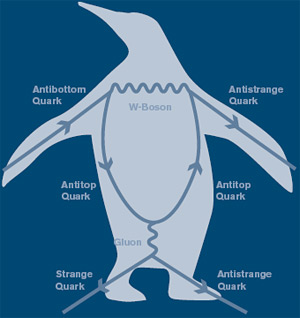 “Mary K. [Gaillard], Dimitri [Nanopoulos], and I first got interested in what are now called penguin diagrams while we were studying CP violation in the Standard Model in 1976… The penguin name came in 1977, as follows. In the spring of 1977, Mike Chanowitz, Mary K. and I wrote a paper on GUTs [Grand Unified Theories] predicting the b quark mass before it was found. When it was found a few weeks later, Mary K., Dimitri, Serge Rudaz and I immediately started working on its phenomenology. That summer, there was a student at CERN, Melissa Franklin, who is now an experimentalist at Harvard. One evening, she, I, and Serge went to a pub, and she and I started a game of darts. We made a bet that if I lost I had to put the word penguin into my next paper. She actually left the darts game before the end, and was replaced by Serge, who beat me. Nevertheless, I felt obligated to carry out the conditions of the bet. For some time, it was not clear to me how to get the word into this b quark paper that we were writing at the time…. Later…I had a sudden flash that the famous diagrams look like penguins. So we put the name into our paper, and the rest, as they say, is history.” John Ellis in Mikhail Shifman’s “ITEP Lectures in Particle Physics and Field Theory”, hep-ph/9510397 |
More than a B factory
BaBar physicists have multiple sources of urgency for the final two years, because this may be the last chance to make certain kinds of measurements. Although the LHC will have a b-quark experiment (LHCb), the existing B factories can do certain measurements that will be difficult or impossible in future experiments.
BaBar and Belle also serve as excellent factories for other particles, especially charm mesons (containing a charm, or c, quark) and tau particles (the heaviest relative of the electron). In fact, physicists are using the plethora of tau particles to look for new physics in a completely different way. They are currently seeking tau decays that end without producing a tau neutrino—finding such decays would be iron-clad proof that something new is going on. It might also help unravel the mystery of how neutrinos change from one kind to another.
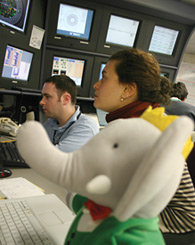 |
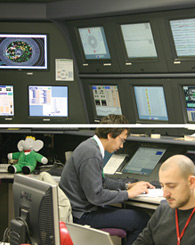 |
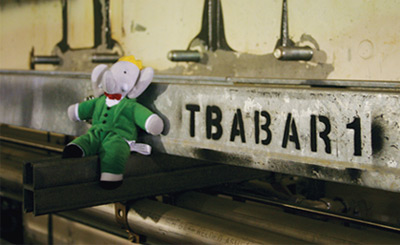 |
|
| Photos: David Harris | |
“The detector is so multipurpose that we can make a wide range of measurements that touch on a wide array of topics,” says Princeton professor Jim Olsen, physics analysis coordinator for BaBar. “We’re learning things that will change textbooks.”
Much more to come
Both B factories are continually pushing their limits in the quest for greater luminosities, or number of events they produce.
At SLAC, the PEP-II accelerator, which provides the electron and positron beams for the BaBar experiment, has already exceeded its original goal for luminosity by a factor of four. The BaBar collaboration and the PEP-II team recently made a number of major upgrades to the detector and the accelerator to further increase luminosity by a dramatic 70 percent, and to make the detector even more sensitive. The final experimental stretch will run from January 2007 through September 2008.
“We have at least 100 kinds of measurements to do in the next two years,” says Olsen. He expects around 150 analyses to be published in this time. “The amount of physics coming out of BaBar is huge.”
Long after the last event flings its offspring through the BaBar detector, physicists in the 600-person international collaboration will be quarrying their mountains of data in a quest to solve the mysteries of the weak force and more.
Click here to download the pdf version of this article.






